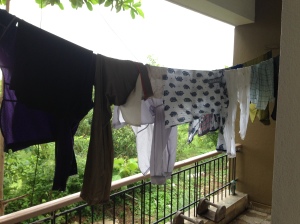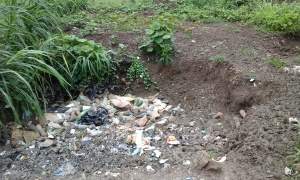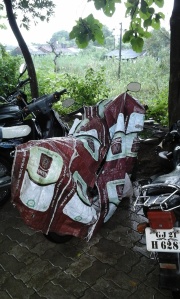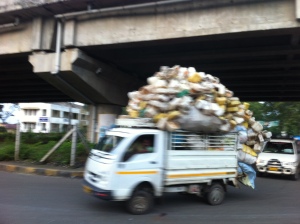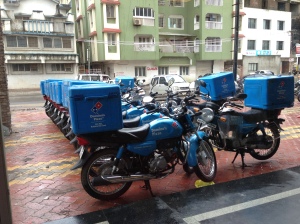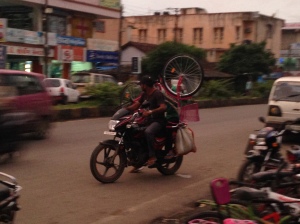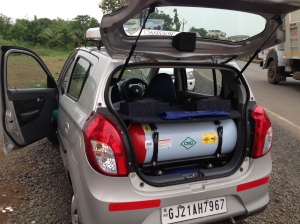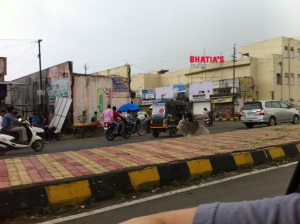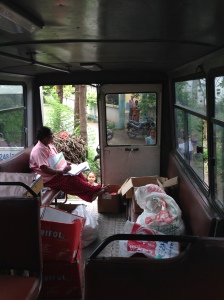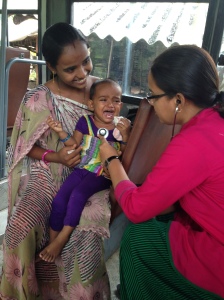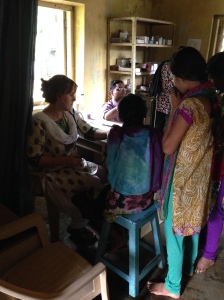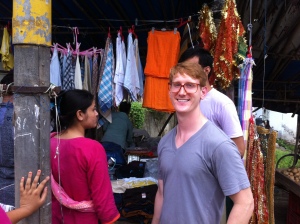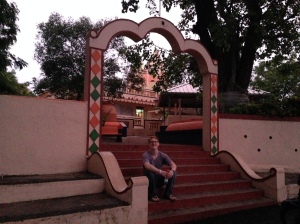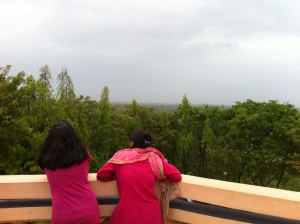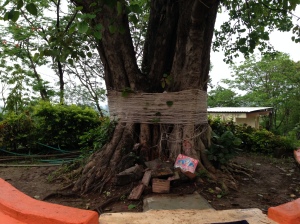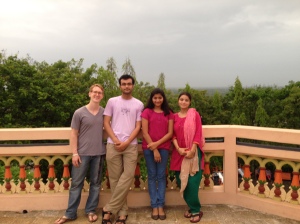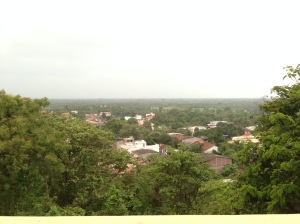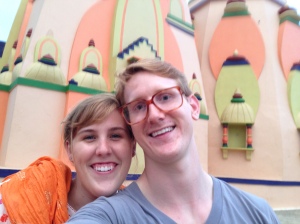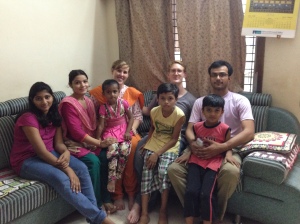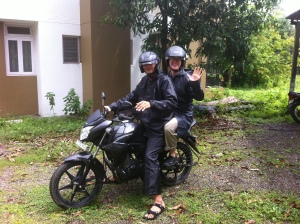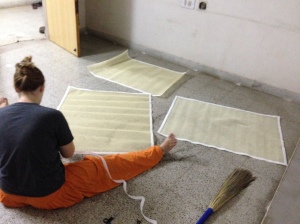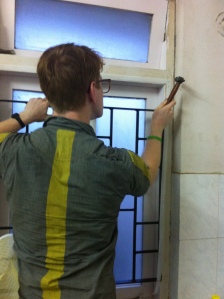Almost everything about the way people live their life seems different in India: people wash their clothes by hand, carpooling is taken to an extreme, and almost everything is reused before being discarded.
There’s a lot that can be learned about how to live sustainably from how people live in India (or how people in my grandparents’ generation lived in America).
When starting to write this post, I was reminded of something my dad shared on my Facebook wall earlier this year. He shared a story about an older woman being chastised at a store for not using reusable bags. The young cashier criticized the older women’s generation for not taking care of the Earth. This prompted the older woman to describe practices that she does and Americans used to do before the “green movement” that are more environmentally conscious than what most people do today. Some of the habits she mentioned are listed below:
- Walking places rather than driving
- Washing cloth diapers rather than using disposable ones
- Returning milk and soda bottles to be sterilized and reused rather than just thrown away
- Drying clothes on the line rather than using energy and a machine to do it
- Wearing hand-me-downs rather than new clothes
- Exercising by working, not using treadmills that require energy
This post reminded me that many of the practices that I observe in India used to be commonplace in America as well.
Energy
One of the most obvious causes for the lower per capita energy usage in India comes from a lack of appliances that are common in America:
- Refrigerators
- Washers
- Dryers
- Dishwashers
- Ovens
- Microwaves
- Air conditioners
- Hot water heaters
I know I’m personally used to having all of these and have complained about doing dishes by hand or taking my clothes to a laundry mat in the past. But living here without most of them (we do have a point of use, tank-less water heater in our shower) has made me realize how much more energy I use in America because of these appliances even when trying to efficiently use appliances: only running full loads of laundry or dishes, using cold water for laundry, turning off the heated dry on the dishwasher, having our thermostat set to temperatures close to those outside, etc.
Farming is very common in rural India – Austin and I have seen lots of sugar cane, rice, and mango tree farms. Unlike in America where the processes is very industrialized – using lots of machinery and few humans – people do everything by hand here. This is beneficial in that their approach provides jobs to more people and doesn’t require expensive equipment that must be maintained.
The electrical outlets all have switches to turn them off to protect appliances from surges but have the added benefit of preventing phantom loads from unused electronics. I’d love to see this building practice brought to America!
In addition to not using energy for appliances, people here are very good about turning off electronics when not in use or lights and fans when they leave a room. There were a few times we forgot to turn our fan off – we’re not used to having one so it’s a new habit to make – and when we did other people in our building were sure bring it to our attention.
After a couple months here, we received our first electrical bill. Back in America, I think my friends would vouch that I’m a pretty “green” or sustainable person. Here in India, I knew that Austin and I had been even more conscious than usual of our energy consumption, so I expected a fairly low bill. I got it a bill for 764 rupees… which meant nothing to me since I had never received a bill here. I went across the hall and casually asked Paresh, “What was your electric bill?” He said, “270 rupees. Why?”…
His bill was a third of ours! He spent the next 5 minutes trying to come up with polite excuses for why our bill may be so large. During the discussion he mentioned that him and his wife don’t even use their hot water heater! The only conclusion I could reach from our discussion was – Austin and I are overconsumptive Americans who can’t even be truely sustainable when we want to be.

No ovens means no cakes. This makeshift tomato Birthday cake was made for me by my friends at the restaurant we went to.
Goods, Consumption, and Waste
Trash in America is kept out of site – it’s picked up and hauled away never to be seen again. This is not the case in India (at least rural India). In Kharel there is no trash service so people just dump their trash somewhere near their home. When Austin and I have filled our bathroom-sized trashcan, we walk behind the hospital, through a field, and dump it into a hole. We are made acutely aware of how much trash our hospital community has made. While staring at the hole of trash that’s in some ways not very big given the number of people that dump into it, I wonder if American’s would generate as much waste (on average over 4 pounds a day) if they had to watch it slowly accumulate week after week, year after year.
When thinking about why there might be less trash generated in India than in America a few thoughts and observations come to mind:
- Food is made from scratch – minimizing the packaging and chemicals used in processed foods
- Grains and beans are bought in bulk – again less packaging
- Families use small trashcans – maybe this provides some psychological priming?
- People use reusable bags and stores in cities often charge customers for disposable bags
- People reuse things before throwing them away:
- Printing paper packaging is used as book protectors
- Beverage bottles are reused
- Newspaper is used as paper towels to put snacks on or as shelf liners
- Old boxes are pressed into plates for to-go ware at restaurants
- Bags that stored grains are sewed together and used as tarps
- There aren’t trashcans in every room – one day I had to wait to get to the cafeteria to throw away a gum wrapper because I couldn’t find a trashcan.
- In general, people buy less stuff here. This is especially apparent with office supplies in the hospital: each desk only has one pen and almost no scrap paper.
- No one uses toilet paper – obviously this isn’t related to waste that usually goes in a trashcan
- Everyone carries around handkerchiefs because disposables like tissues and paper towels aren’t common here – this is also true for diapers; kids just wear underwear here and get wiped down after going to the bathroom. The one year old that lives next to us has both pooped and peed on our floor (but we still adore her fun, sassy personality).
- Homes are smaller here and less filled with stuff that will likely one day be thrown away.
The diet in India is primarily vegetarian and omnivores are more similar to what hunter gathers used to be in that they only eat meat once or twice a week. This is much better for the environment than the typical American diet that has meat as a primary component. Meat production requires more energy (think of all the grain animals have to eat before we can eat them), requires more water than plants, cows especially release high levels of greenhouse gases like methane, and many animals are given antibiotics before they are sick which leads to antibiotic resistant strands of bacteria that we can then be infected with. (Even just cutting back on one’s meat consumption can have a big impact so consider giving Meatless Mondays a try).
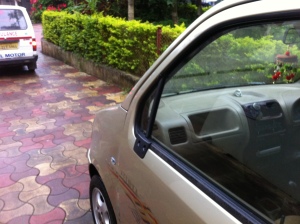
In India, people who choose to buy cars have to pay for a mirror on the passenger side. Not sure if this one is a positive because it discourages unnecessary consumption or is a negative for safety reasons…
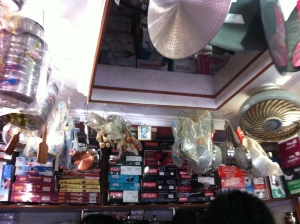
Space is definitely a commodity in India – this shop where we bought some kitchen supplies was filled to the brim with products, had things hanging all over the ceiling, and had an attack that stored even more.
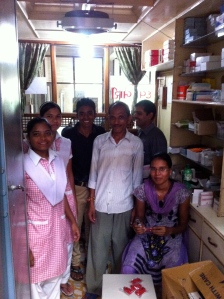
I spent a week working in this tiny pharmacy with this group of people – both standing and sitting space were scarce here.
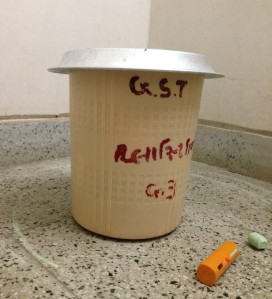
This is our tiny trashcan – we keep a plate on it and chemical chalk around it to keep the thriving insect population out of it.

India is very good about labeling items as vegetarian and restaurants as vegetarian friendly. Even this box of cereal has a symbol on it marking it as “100% Veg.”
Transportation
As we’ve mentioned before, roads are dramatically different in India – the experience of riding in a taxi in Mumbai should be turned into a video game. There are something I would like to see become more common; things like wearing seat belts or helmets, using blinkers, and staying within lanes. Nevertheless, there are a few practices America could definitely benefit from adopting.
- Single Occupancy Vehicles (SOVs) are rare – Even people with cars often use a scooter or motorcycle for trips when it’s only one or two people going.
- Bikes, motorcycles, trains and buses are super common.
- Car pooling is taken to an extreme.
- There are lots of vehicles that run on compressed natural gas which they’re able to refill at most gas stations.
- Roads are shared by cars, trucks, bikes, motorcycles, pedestrians (and animals: cows, donkeys, dogs, goats).

At the end of a festival celebrating Ganpati – the most popular Hindu deity in India- statues are taken to a river, dunked 7 times (with a wish made the seventh time), and released into the river. We all piled into this truck for the adventure after throwing colored powder at each other. This truck is very full (Austin is actually in there too)!
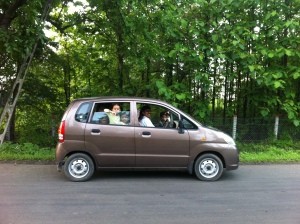
On one of our nightly walks we got passed by this rowdy car filled with 3 adults and at least 6 kids from the hospital apartments we live in.
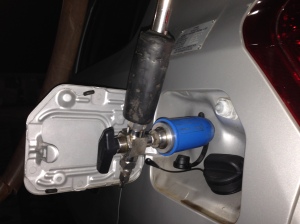
When Paresh stopped to get gas with us, we were interested to see what the pump for natural gas looked like. As a safety precaution, we all had to get out of the vehicle while pumping.
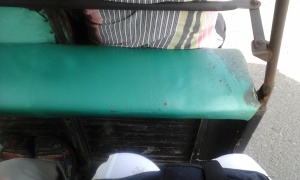
Austin and I got to ride a Rickshaw to a nearby town (Chikhli). Our Rickshaw fit an impressive 13 people – the middle row that we were in had a small bench at our knees for children to sit on.
Much of my commentary has focused on the actions of individuals and hasn’t accounted for general air and water quality or the difference in population of size between America and India (300 million versus 1.2 billion). Because of India’s size but lack of infrastructure, there are definitely areas they need to work on as a country. Nevertheless, given America’s relatively small population, it’s actually quite impressive how large of a portion of the world’s resources we consume – for example American’s consumer a quarter of the world’s energy and operate a third of the automobiles.
While in college, I spent much of my time outside of class working to reduce the environmental impact of my university and myself. The initiatives I worked on encouraged people to make small changes to reduce their impact – recycle more, use fewer items that are only used once, turn off the lights when you leave a room. Living here makes me frustrated that we couldn’t get more people to take these small actions to reduce their impact while also making me want to push my fellow Americans do alter their behaviors even more.
That’s all for now – here’s a cute picture of the baby I mentioned 🙂
